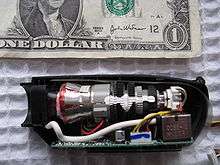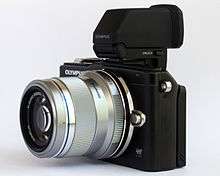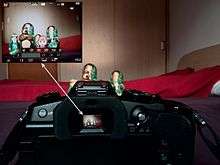Electronic viewfinder
An electronic viewfinder (EVF) is a camera viewfinder where the image captured by the lens is projected electronically onto a miniature display. The image on this display is used to assist in aiming the camera at the scene to be photographed. It differs from a live preview screen in being smaller and shaded from ambient light.
The sensor records the view through the lens, the view is processed, and finally projected on a miniature display which is viewable through the eyepiece. Electronic viewfinders are used in digital still cameras and in video cameras.
Some cameras (such as Panasonic, Sony, Fujifilm) have an automatic eye sensor which switches the display from screen to EVF when the viewfinder is near the eye. More modest cameras use a button to switch the display. Some have no button at all.[1]

In still photography


Advantages
Like the live preview screen, electronic viewfinders can show additional information, such as an image histogram, focal ratio, camera settings, battery charge, and remaining storage space. Some have a focus peaking feature that highlights areas of the frame that are in focus. They are also in several ways more accurate than an optical viewfinder (OVF):
- Show the scene from the same viewpoint as the camera lens, without parallax.
- Cope with high zoom-ratio lenses, without needing a bulky reflex mirror.
- Show approximately how the scene will look under the chosen exposure, including white balance, saturation, effects etc.
- Show a low-light scene brighter than it would appear with a OVF, just like the final image will look like.
- Show 100% coverage of the final image.
- It is possible to review taken images on the EVF. This might be helpful in bright sunlight.
- The EVF can also be used in video mode (which is not possible in a OVF)
- Uses less power than the big LCD screen.
Limitations
Electronic viewfinders have the following limitations:
- There may be a noticeable lag between the changes in the scene and the electronic viewfinder display.
- A very few EVFs do not have automatic gain control and become virtually blank in low-light conditions.
- EVFs of compact and bridge cameras with smaller sensors have difficulty operating in darker environments and tend to lag severely.
Electronic viewfinders have been in use with bridge cameras for some years but with limited resolution and image quality. They are used in most mirrorless modern system cameras (e.g. Panasonic Micro Four Third System, Sony NEX, Sony SLT, Nikon V1).
Many professional photographers and advanced amateurs prefer DSLR cameras that have a true optical through-the-lens viewfinder (OVF). From 2006 some DSLR camera models provide both through-the-lens viewing and a "live preview" on the LCD (as distinct from an electronic viewfinder). These include, but are not limited to, the Olympus E-330, E-410, E-510 and E-3, the Panasonic Lumix DMC-L1 and DMC-L10, the Leica Digilux 3, the Canon EOS 40D, EOS 50D, EOS 60D, EOS 7D and EOS-1D Mark III, and the Nikon D3, D300 and D90.
Hybrid viewfinder
To get the advantage of both optical and electronic viewfinders some cameras have hybrid viewfinders. These display the image in an optical eyepiece viewfinder, or electronically on an LCD screen. Examples include some Fujifilm X-series cameras.
See also
References
- ↑ Darren Rowse. "Should I use the LCD or Viewfinder on my Digital Camera?". Retrieved February 11, 2015.